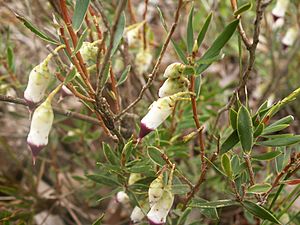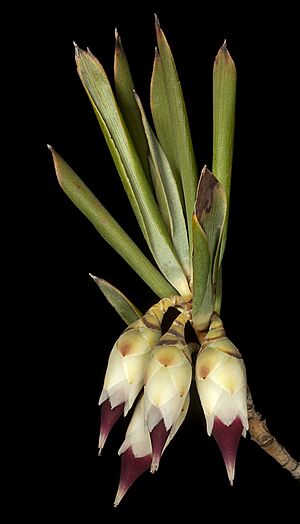Pearl flower facts for kids
Quick facts for kids Pearl flower |
|
|---|---|
 |
|
| Conostephium pendulum near Bunbury | |
| Scientific classification | |
| Genus: |
Conostephium
|
| Species: |
pendulum
|
The Conostephium pendulum, often called pearl flower, is a small, open shrub. It belongs to the plant family Ericaceae. This plant is special because it only grows in a specific area of Western Australia, called the Swan Coastal Plain, stretching from Eneabba to Margaret River.
What Does It Look Like?
The pearl flower is a small shrub, usually growing up to 1 meter (about 3 feet) tall. Its leaves are long and narrow, about 2.5 centimeters (1 inch) in length, and have a sharp tip.
The flowers bloom from June to September. They are creamy white with a reddish-purple tip. Each flower is about 11 millimeters long and shaped like a tube. A part of the flower called the style sticks out from the tube. These pretty flowers hang down by themselves from where the leaves meet the stem.
How It Got Its Name
The pearl flower was first named by a scientist named George Bentham in 1837. He described it in a book about plants from Western Australia. The plant was discovered by Charles von Hügel.
The name pendulum comes from a Latin word that means 'hanging down' or 'drooping.' This describes how the flowers hang from the plant.
Where It Grows
The pearl flower grows in sandy soils. You can often find it in areas with Banksia trees or in open heathlands, especially in the northern parts of its range.
This plant is the most common and widespread type of Conostephium. It grows in many different parts of Western Australia, including the Swan Coastal Plain, Avon Wheatbelt, Geraldton Sandplains, Jarrah forest, and Warren regions.
Growing Pearl Flowers
The pearl flower is not commonly grown in gardens. However, if you wanted to grow it, you might try caring for it in a similar way to other plants in the Ericaceae family, like heather or rhododendron.


